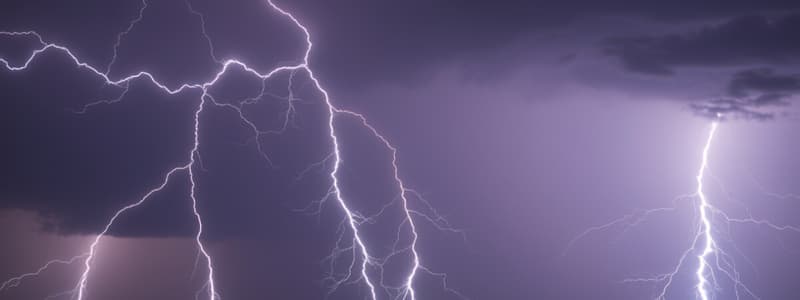Podcast
Questions and Answers
What creates the electrical charges in a cumulonimbus cloud that cause lightning?
What creates the electrical charges in a cumulonimbus cloud that cause lightning?
The movement of water droplets and ice crystals creates electrical charges, with positive charges forming at the top and negative charges at the bottom.
How can one determine the distance of a storm using thunder?
How can one determine the distance of a storm using thunder?
Count the seconds between seeing lightning and hearing thunder, then divide that number by 5 to find the distance in miles.
What distinguishes intra-cloud lightning from inter-cloud lightning?
What distinguishes intra-cloud lightning from inter-cloud lightning?
Intra-cloud lightning occurs within a single cloud, while inter-cloud lightning happens between two separate clouds.
Explain the difference between cloud-to-ground and cloud-to-air lightning.
Explain the difference between cloud-to-ground and cloud-to-air lightning.
Describe the appearance of forked lightning and its range from thunderstorms.
Describe the appearance of forked lightning and its range from thunderstorms.
Why does the ground's positive charge concentrate around tall objects during a lightning event?
Why does the ground's positive charge concentrate around tall objects during a lightning event?
What is ball lightning and how does its appearance typically manifest?
What is ball lightning and how does its appearance typically manifest?
What is the approximate temperature of a lightning bolt and how does it compare to the surface of the Sun?
What is the approximate temperature of a lightning bolt and how does it compare to the surface of the Sun?
Explain the conditions required for intra-cloud lightning to occur.
Explain the conditions required for intra-cloud lightning to occur.
What visual phenomena can be observed when lightning jumps out of a cumulonimbus cloud?
What visual phenomena can be observed when lightning jumps out of a cumulonimbus cloud?
Flashcards are hidden until you start studying
Study Notes
Causes of Lightning
- Movement of water droplets and ice crystals in cumulonimbus clouds creates electrical charges.
- Positive charges accumulate at the top of the cloud, while negative charges gather at the bottom.
- Ground beneath the cloud develops a positive charge, attracted to the negative charge in the cloud.
- Positive charge on the ground concentrates around tall objects, enhancing the likelihood of a lightning strike.
- Connection between positive ground charge and negative cloud charge results in a lightning discharge.
Amazing Facts about Lightning
- A lightning bolt reaches approximately 29,000 degrees Celsius, significantly hotter than the Sun’s surface.
- Global occurrence of lightning flashes exceeds 3 million per day, averaging about 40 flashes per second.
- An average lightning bolt can power a 100-watt light bulb continuously for over three months.
- Lightning travels along a path comparable in width to a thumb.
- Lightning causes about 2,000 fatalities annually; safety is critical during storms to avoid strikes.
- Distance of storms can be estimated using thunder; count seconds between lightning and thunder, divide by five for distance in miles.
Types of Lightning
- Cloud-to-Ground Lightning: Most recognized type, strikes from negatively charged cloud bottom to positively charged ground. Often targets tall structures, causing fires and damage.
- Cloud-to-Air Lightning: Involves a discharge from a cloud into clear air, visually striking and can occur adjacent to a storm.
- Inter-cloud and Intra-cloud Lightning: Inter-cloud occurs between different clouds, while intra-cloud is contained within a single cloud and is the most prevalent type. Appears as bright flickering flashes.
- Forked Lightning: Characterized by jagged, branching appearance, capable of striking from clouds to the ground or between clouds, reaching up to 10 miles from a storm.
- Ball Lightning: A rare phenomenon appearing as luminous spheres, typically around 30 cm in diameter, can emit hissing sounds and may explode.
Studying That Suits You
Use AI to generate personalized quizzes and flashcards to suit your learning preferences.




